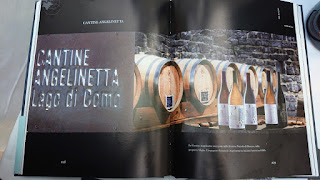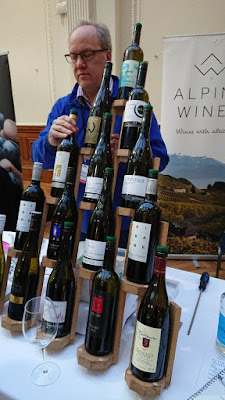SITT was smaller this February at Lynley Hall, off Vincent Square, London but that didn't mean it was any less interesting.
The big news was Verdese di Como, a grape rescued practically from extinction by Cantine Angelinetta, Lago di Como.
A young couple, Emanuele and Eleonora Angelinetta have made what seems to be the only 100% Verdese wine currently in existance. Mentioned neither in 'Wine Grapes' nor in 'Native Wine Grapes of Italy' Verdese di Como is a rarity indeed.
Fortunately Galet has an entry:
VERDESE DI COMO m.
Syn. : Verdesa, Verdese (Como), Verdetto a San Colombano, Verdona (Abbiate Guazzone), Verdamm dans le Milanais (Molon), Bianca Maggiore (Marzotto).
Cepage de cuve blanc italien, signale par Molon et decrit recemment par Calo.
Bourgeonnement cottoneux vert jaunatre.
Feuille moyenne, plane, un peu bullee, entiere ou trilobee a sinus superieures peu profonds, ouverts, sinus petiolaire en U ouvert: dents courtes, ogivales; dessous du limbe duveteux avec les nervures principales pubescentes. Grappe courte, conique, compacte; baie grosse, ovoide, a peau verdatre, meme a maturite, saveur simple. Maturite 3e epoque.
We reproduce this in full as a tribute to the great man who died on the last or penultimate day of last year. We must get a handle on the Ampelographical terms one day although we suspect our relationship to ampelography will be what Isaiah Berlin described as that of a football hooligan to Philosophy. How Pierre Galet was able to write entries such as this for thousands of other grape varieties in his monumental 'Dictionnaire Encyclopedique des cepages et de leurs synonymes' is unimaginable.
Giovanni Brumana seen here with Sra Brumana is the Director of Orsa Major Ltd, importers of Italian wines.
Orsa Major embodies what we like most about SITT.
Company Profile
What do we know about wine? First of all we
drink it, we love it and we want to share it. Our aim is to let people
know that behind a simple bottle of wine there are interesting stories,
passion and hard work. We decided to present small local traditional
productions like the ones we host here today. A kind of a rarity because
they are entirely produced, bottled and consumed locally. We chose
Lombardy wines because we know the region well as we are ourselves from
there.
Galet's entry mentions 'saveur simple' and one can't argue with that. However the wine is pleasant and refreshing. Verdese di Como is certainly worth saving from extinction.
Orsa Major also fielded four Franciacortas, and four wines from Cantina Bergamasca including a Moscato di Scanzo which we had first encounered at BING, Barolo and an Incrocio Manzoni. Cantina Bergamasca also produces a wine made from Incrozio Terzi, a Barbera/Cabernet Sauvignon crossing (not present at this tasting).
Verdese di Como wasn't the only grape brought back from extinction. At the Sonvino table we found a wine called Vinolus Kalecik Karasi.
Kalecik is a Turkish variety rescued by Professor Dr. Yusuf Sabit Agaoglu of Ankara University. The following is a google translation of a Turkish description of Prof. Sabit Agaoglu's work with Kalecik (Karasi means 'red');
He is a professor who retired from Ankara University Faculty of Agriculture, where he worked for many years, and produces small amounts of great wines in his boutique winery located in the budcukbağ, which he founded in Kalecik. Following the trace of the Kalecik Karası grape, which was about to disappear, he made his subject to his doctoral thesis and saved him from extinction. ie if one of the current Kalecik black grape is known thanks to his turkey (sic).
It produces the wines that it sells under the trajan brand with completely spontaneous fermentation and does not use the keg because it thinks it is incompatible with the spirit of the goalkeeper land. wines are generally medium tanned and stand out with their fruitiness on the palate.
It has encouraged people to do proper viticulture in a small town like Kalecik for years, but unfortunately this vision has not been found in the public. On top of that, when regulations and state policies overlapped, Kalecik remained a closed small town that could not produce added value.
He blended the wines he produced in 2014-2015 and 2016 for his beloved wife, whom he lost a few years ago, and bottled in his memory with the label "Gülcihanlı years". I recommend people who are interested in wine to meet him
Although specialising in Turkey and Bulgaria, Sonvino also had an interesting Spanish wine from the Cayetana Blanca variety. Cayetana is another of Spain's secrets. It has many synonyms including Baladi which is a name given also to a native grape of the Holy Land making wines as we have seen in Israel and the West Bank - unrelated to Cayetana. In Portugal it is Mourisco Branco. In Australia it is known as Doradillo not to be confused with Doradilla which is a native grape of Malaga. Interesting if potentially confusing.
At Panda Fine Wine, we found another rarity, a Chinese grape called Beichun. Described as a winter-hardy hybrid, Beichun has Muscat of Hamburg and a Chinese wild species called Ruprecht (Vitis Amurensis). It makes a lovely wine: a very pleasant surprise.
Galet's entry mentions 'saveur simple' and one can't argue with that. However the wine is pleasant and refreshing. Verdese di Como is certainly worth saving from extinction.
Orsa Major also fielded four Franciacortas, and four wines from Cantina Bergamasca including a Moscato di Scanzo which we had first encounered at BING, Barolo and an Incrocio Manzoni. Cantina Bergamasca also produces a wine made from Incrozio Terzi, a Barbera/Cabernet Sauvignon crossing (not present at this tasting).
Verdese di Como wasn't the only grape brought back from extinction. At the Sonvino table we found a wine called Vinolus Kalecik Karasi.
 |
| Yusuf Sabit Agaoglu, saviour od Kalecik Karasi |
He is a professor who retired from Ankara University Faculty of Agriculture, where he worked for many years, and produces small amounts of great wines in his boutique winery located in the budcukbağ, which he founded in Kalecik. Following the trace of the Kalecik Karası grape, which was about to disappear, he made his subject to his doctoral thesis and saved him from extinction. ie if one of the current Kalecik black grape is known thanks to his turkey (sic).
It produces the wines that it sells under the trajan brand with completely spontaneous fermentation and does not use the keg because it thinks it is incompatible with the spirit of the goalkeeper land. wines are generally medium tanned and stand out with their fruitiness on the palate.
It has encouraged people to do proper viticulture in a small town like Kalecik for years, but unfortunately this vision has not been found in the public. On top of that, when regulations and state policies overlapped, Kalecik remained a closed small town that could not produce added value.
He blended the wines he produced in 2014-2015 and 2016 for his beloved wife, whom he lost a few years ago, and bottled in his memory with the label "Gülcihanlı years". I recommend people who are interested in wine to meet him
 |
| The helpful and informed Serhat Narsap, DipWSET |
At Panda Fine Wine, we found another rarity, a Chinese grape called Beichun. Described as a winter-hardy hybrid, Beichun has Muscat of Hamburg and a Chinese wild species called Ruprecht (Vitis Amurensis). It makes a lovely wine: a very pleasant surprise.
Michael Sun was representing Panda Fine Wines and we remembered him from previous shows.
He had introduced us to this wine from the Longyan native Chinese grape variety. Wine Grapes describes Longyan as an old Chinese variety of unknown origin. Strangely, Longyan is a vinifera grape so it must have been brought to China at some stage long ago. It is quite widely planted in China.
Another surprise was a Chinese Rkatsiteli. Amazing to find this grape in China at all (although its cold-hardiness makes this understandable) but extra-surprising to find that this version from the same winery as the Beichun, the Puchang vineyard (Xingjiang) was absolutely marvellous, perhaps the best Rkatsiteli we have ever tasted. Puchang also work with Saperavi and Riesling Italico among others.
As if all this wasn't enough excitement for one afternoon, Alpine wines had a Swiss crossing of Chasselas and Chardonnay called Doral. The name rang a bell but here it was in reality. Marvellous.
Originally Nick Dobson Wines, it is heartening to see how the company has expanded and florished as Alpine Wines under Joelle Nebbe-Morno.It's 'institutional memory' is very much alive. How often can you say that?
But what was this? The very same Romano for which we once trekked to Wimbledon to acquire. Romano is the name given to this Chilean wine purporting to come from the minor Burgundian grape Cesar. Check our previous posts on this subject.
Jackson Nugent Vintners are the enterprising importers of this fascinating and once you have allowed it to breathe, delicious wine.
Johnny Bingham heads Agency Sales for JNV. There can be no more affable person in the wine world. He was clearly delighted that we had discovered their Casa Silva Romano. Indeed he had another rarity from the same Chilean producer: Casa Silva Sauvignon Gris.
We had come across Sauvignon Gris before under its synonym Fie Gris. It is a colour mutation of Sauvignon Blanc.
Johnny had something else we had never seen before, a Pinot Blanc from Muscadet.
To round off this productive visit, a Posip from Korkula, one of the larger islands off the Croatian coast.
We had last tasted Posip in 2010 and hadn't exactly been bowled over but this one was outstanding: Deliciously aromatic. Individual too.
A great way to leave this small but eye-opening tasting.


























No comments:
Post a Comment